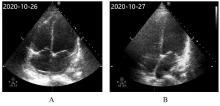| 1 |
VAN DIEPEN S, KATZ J N, ALBERT N M, et al. Contemporary management of cardiogenic shock: a scientific statement from the American heart association[J]. Circulation, 2017, 136(16): e232-e268.
|
| 2 |
REDFORS B, ANGERÅS O, RÅMUNDDAL T,et al. 17-year trends in incidence and prognosis of cardiogenic shock in patients with acute myocardial infarction in western Sweden[J]. Int J Cardiol, 2015, 185: 256-262.
|
| 3 |
THIELE H, OHMAN E M, DE WAHA-THIELE S, et al. Management of cardiogenic shock complicating myocardial infarction: an update 2019[J]. Eur Heart J, 2019, 40(32): 2671-2683.
|
| 4 |
KOLTE D, KHERA S, ARONOW W S, et al. Trends in incidence, management, and outcomes of cardiogenic shock complicating ST-elevation myocardial infarction in the United States[J]. J Am Heart Assoc, 2014, 3(1): e000590.
|
| 5 |
JEGER R V, RADOVANOVIC D, HUNZIKER P R, et al. Ten-year trends in the incidence and treatment of cardiogenic shock[J]. Ann Intern Med, 2008, 149(9): 618-626.
|
| 6 |
OUWENEEL D M, SCHOTBORGH J V, LIMPENS J,et al. Extracorporeal life support during cardiac arrest and cardiogenic shock: a systematic review and meta-analysis[J]. Intensive Care Med, 2016, 42(12):1922-1934.
|
| 7 |
BURZOTTA F, RUSSO G, BASILE E, et al. How to choose between intra-aortic balloon pump, Impella and extracorporeal membrane oxygenation[J]. G Ital Cardiol (Rome), 2018, 19(6 ): 5S-13S.
|
| 8 |
VALLABHAJOSYULA S, O’HORO J C, ANTHARAM P, et al. Concomitant intra-aortic balloon pump use in cardiogenic shock requiring veno-arterial extracorporeal membrane oxygenation[J]. Circ Cardiovasc Interv, 2018, 11(9): e006930.
|
| 9 |
CEVASCO M, TAKAYAMA H, ANDO M, et al. Left ventricular distension and venting strategies for patients on venoarterial extracorporeal membrane oxygenation[J]. J Thorac Dis, 2019, 11(4): 1676-1683.
|
| 10 |
KHIR A W, BRUTI G. Intra-aortic balloon shape change: effects on volume displacement during inflation and deflation[J]. Artif Organs, 2013, 37(7): E88-E95.
|
| 11 |
RUSSO J J, ALEKSOVA N, PITCHER I, et al. Left ventricular unloading during extracorporeal membrane oxygenation in patients with cardiogenic shock[J]. J Am Coll Cardiol, 2019, 73(6): 654-662.
|
| 12 |
WERDAN K, GIELEN S, EBELT H, et al. Mechanical circulatory support in cardiogenic shock[J]. Eur Heart J, 2014, 35(3): 156-167.
|
| 13 |
REYENTOVICH A, BARGHASH M H, HOCHMAN J S. Management of refractory cardiogenic shock[J]. Nat Rev Cardiol, 2016, 13(8): 481-492.
|
| 14 |
FUJINO T, IMAMURA T, KINUGAWA K. Future perspectives of intra-aortic balloon pumping for cardiogenic shock[J]. Int Heart J,2020,61(3): 424-428.
|
| 15 |
HOU D B, YANG F, HOU X T. Clinical application of intra-aortic balloon counterpulsation in high-risk patients undergoing cardiac surgery[J]. Perfusion, 2018, 33(3): 178-184.
|
| 16 |
LE GALL A, FOLLIN A, CHOLLEY B, et al. Veno-arterial-ECMO in the intensive care unit: from technical aspects to clinical practice[J]. Anaesth Crit Care Pain Med, 2018, 37(3): 259-268.
|
| 17 |
NUDING S, WERDAN K. IABP plus ECMO-Is one and one more than two? [J]. J Thorac Dis,2017,9(4): 961-964.
|
| 18 |
LUND L W, HATTLER B G, FEDERSPIEL W J. Is condensation the cause of plasma leakage in microporous hollow fiber membrane oxygenators[J]. J Membr Sci, 1998, 147(1): 87-93.
|
| 19 |
BARDÓN R G, DUBINI G, PENNATI G. A computational model of heat loss and water condensation on the gas-side of blood oxygenators[J]. Artif Organs, 2018, 42(11): E380-E390.
|
| 20 |
SCHROETER T, VOLLROTH M, HÖBARTNER M,et al. Influence of ECMO and IABP on coronary blood flow. Valuable combination or waste of resources? [J]. Med Klin Intensivmed Notfmed,2015,110(3): 210-216.
|
| 21 |
MOJOLI F, BOUHEMAD B, MONGODI S, et al. Lung ultrasound for critically ill patients[J]. Am J Respir Crit Care Med, 2019, 199(6): 701-714.
|
| 22 |
PICANO E, SCALI M C, CIAMPI Q, et al. Lung ultrasound for the cardiologist[J]. JACC Cardiovasc Imaging, 2018, 11(11): 1692-1705.
|
| 23 |
BERBENETZ N, WANG Y J, BROWN J, et al. Non-invasive positive pressure ventilation (CPAP or bilevel NPPV) for cardiogenic pulmonary oedema[J]. Cochrane Database Syst Rev, 2019, 4(4): CD005351.
|
| 24 |
CONDELLO I. Water condensation and gas exchange correlation in different models and fibers of blood oxygenators: “how can we improve performance? ”[J]. J Extra Corpor Technol, 2020, 52(1): 43-51.
|
| 25 |
BARAN D A, GRINES C L, BAILEY S, et al. SCAI clinical expert consensus statement on the classification of cardiogenic shock: this document was endorsed by the American College of Cardiology (ACC), the American Heart Association (AHA), the Society of Critical Care Medicine (SCCM), and the Society of Thoracic Surgeons (STS) in April 2019[J]. Catheter Cardiovasc Interv, 2019, 94(1): 29-37.
|
 )
)







